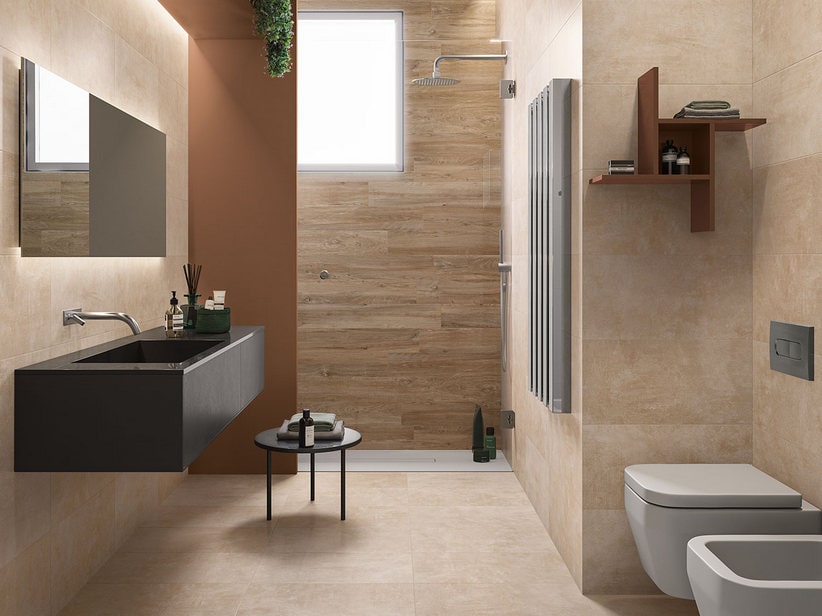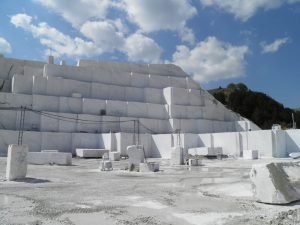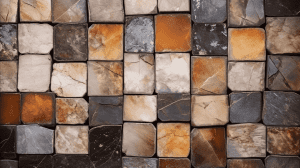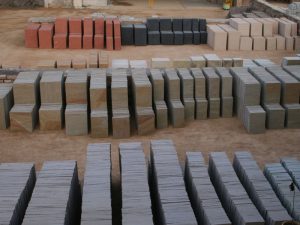Natural stones are so captivating. They bring a feeling of natural, organic beauty and authenticity to every environment in which they are used. However, like every natural material, their appearance changes through time and they need to be properly cleaned and maintained so as not to lose their beauty and shine. In this article, we tell you everything you need to know about natural stone cleaning without damaging or dulling the stone.

First things first: Get to know your stone.
The first thing that you should understand before beginning the natural stone cleaning process, is the geographical classifications and composition properties of the stone since it can help you select the best type of cleaner and method of care suitable for your natural stone.
Generally, natural stones can be classified into three main geological classifications based on their formation processes which are as follows: igneous, Metamorphic, and Sedimentary. Furthermore, the stones in each category can be either Siliceous or Calcareous.
Calcareous stones are mostly made of a component called Calcium Carbonate, a mineral commonly found in natural stones, pearls, and shells such as marble, travertine, and limestone. Calcium Carbonate is acid-sensitive; therefore, calcareous stones should not be washed with acidic cleaners.
Siliceous stones, as their name suggests, are primarily composed of Silicates, such as mica, quartz, feldspar, etc. These types of stones are quite resistant to most acidic solutions in kitchen settings but still, it’s better not to use acidic cleaners since they might contain some level of minerals that are somewhat sensitive to acids.
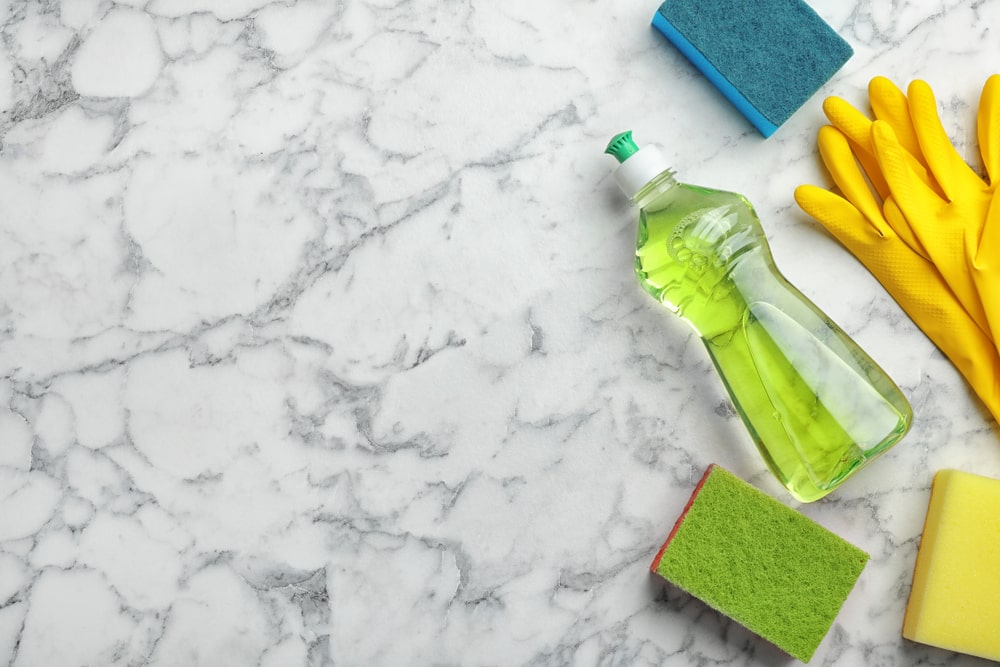
Routine natural stone cleaning and maintenance for all sorts of areas:
- Floor surfaces
Due to their abrasiveness, sand, grit, and dirt can heavily damage and scratch the natural stone surfaces; that is why it’s important to dust mop the floor surfaces to get rid of these particles. The natural stone cleaning and maintenance method for floor surfaces includes washing the floor using a dry, clean dust mop with neutral pH7 cleaners and water. You can also use mats or rugs with non-slip undersides on the inside and outside of the entrance floor to minimize these unwanted particles.
- Exterior stone maintenance
Tiles of stones on the exterior of the building are regularly exposed to various sorts of pollution such as air pollution, car exhausts, rain, winds, etc. and similar to stones in other areas, they also should be maintained and cleaned frequently; however, it’s unlikely to be able to use normal methods of natural stone cleaning for exterior stones due to their large size and sensitive position. In this case, you can take advantage of professional cleaners who provide exterior natural stone cleaning services using specific cleaners and equipment.
- Countertop and vanity top surfaces
Clean the countertop or vanity top surface using warm water, stone soap, and a few drops of a neutral stone cleaner. For the best result, use a soft, clean, and preferably white cloth for wiping off the mix of water and cleaner afterward. Never use too much stone soap or cleaner since it might leave stains on the surface of natural stone. Also, remember to never use cleaner products containing acidic ingredients like lemon, particularly for stones like marble or limestone. Moreover, products such as scouring powders or creams should not be used either since they contain abrasive particles that may scratch the stone surface.
- Patio and outdoor pool areas
Although it’s not recommended to use cleaners that contain acids or bleach for natural stone cleaning, in areas such as hot tubs, patios, and outdoor pool areas, you can make use of a mild bleach solution to get rid of moss or algae and afterward, flush with clean water.
- Bathtub and bathroom
Bathroom walls made out of natural stone or stone sink can be cleaned with the use of water and neutral stone cleaner. Also, soap scum in the bathtub can be cleaned using either a non-acidic soap scum remover or a solution of water and ammonia (approximately 1/2 cup of ammonia to a gallon of water), however, ammonia solution cannot be overused or frequently used since it can gradually dull the surface of the stone. Also, cleaning the bathtub with a squeegee after each use can significantly reduce the soap scrums.
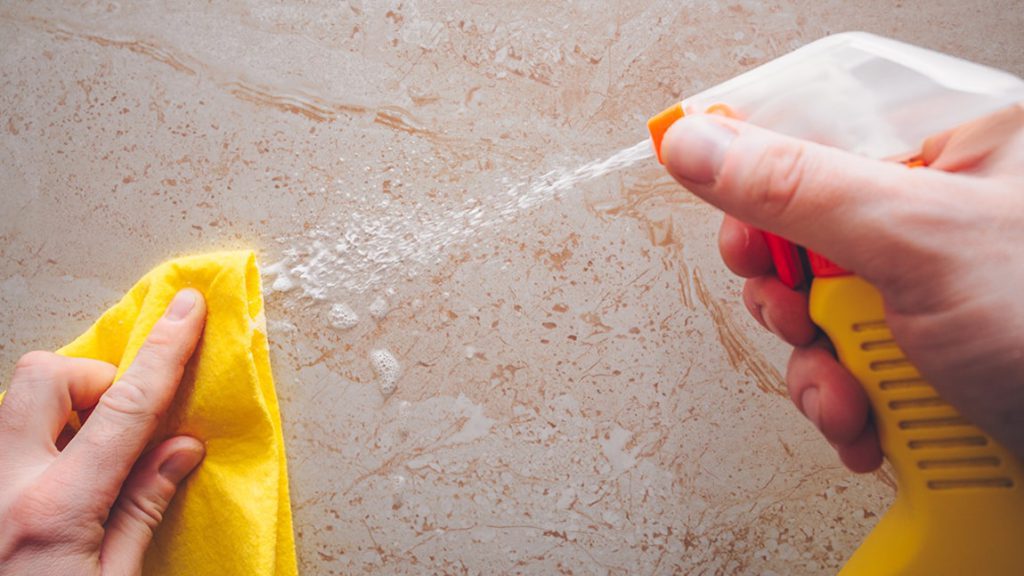
General steps for natural stone cleaning of any type
- First, sweep or dust mop to get rid of any unwanted particles.
- Fill a bin or bucket with warm water and add in a few drops of a neutral pH cleaner specifically for stones to create a solution of water and stone cleaner. Change the solution whenever necessary.
- Dip a clean, preferably microfiber cloth, mop, or towel in the solution and start cleaning the stone surface.
- Your starting point for natural stone cleaning should be the corner of the room or stone area then gradually precede towards the room exit.
- Let the air circulate through the room or area so it can be dried faster.
General guidelines for stain removal
Stain identification: What type of stain is it?
If you have a stain on the stone surface that you want to remove, the first step is to identify the stain. Stains can be organic, metallic, oil-based, biological, ink-based, acid-based, or paint and each of these types of stains has a specific cleaner that can be used to clean the stain. In the following section, we explain the types of stains and how to select and use a cleaner product to remove the stain accordingly and afterward dive through the natural stone cleaning process.
Organic stains
Organic stains are stains caused by tea, coffee, food, urine, tobacco, etc. This type of stain creates a pinkish-brown stain and significantly fades when the source of the stain is removed. If the stain is in the outdoor areas, after the source of the stain is removed, sun and rain will gradually bleach and fade the stain but if the stain is within indoor areas, you can clean it using a few drops of ammonia and 12% Hydrogen Peroxide.
Metallic stains
Stains caused by iron, rust, bronze, copper, etc. can be counted as metallic stains and if they are deep-seated in the stone, they can be very tricky and difficult to remove and leave a permanent stain on the stone. Metallic stains follow the shape of the source such as nails. Cans, screws, or metal furniture. Iron or rust stains are usually in the color of brownish orange while stains caused by bronze or copper have a green almost muddy-brown color. Metallic stones should be cleaned using a poultice, which is a liquid cleaner made of chemicals mixed with white absorbent material and can significantly remove and fade the metallic stains.
Biological stains
Biological stains are those that are caused by to natural reactions of plants and living things such as algae, fungi, mildew, or moss. To get rid of these stains, clean the stone area using a diluted cleaning solution. Make use of a gallon of water mixed with 1/2 cup of bleach, hydrogen peroxide, or ammonia. Never mix bleach and ammonia.
Oil-based stains
Cosmetics, milk, cooking oil, tar, grease, or plumber’s putty leave oil-based stains behind. This type of stain darkens the stone and usually should be chemically dissolved with the source of the stain rinsed away. You can clean oil-based stains gently using a liquid cleaner such as acetone, household detergents, or mineral spirits.
Ink based stains
Pen, ink, and markers can create ink-based stains on natural stones. If your stone is of light color, you can clean this type of stain using Hydrogen Peroxide or bleach but on dark stones, you can use acetone or liquor thinner to get rid of ink-based stains.
Paint stains
For removing paint stains, a small amount of paint can be removed using a liquor-thinner and a razor blade to scrape the paint off the stone surface. However, the heavy-painted surfaces can only be removed using a commercial “heavy liquid” paint stripper. To remove the stain using this product, strictly follow the manufacturer’s instructions and then rinse the area with clean water. however, they might etch the stone surface and you have to repolish the stone afterwards. Remember to follow the safety guidelines while using this product.
Efflorescence
Efflorescence is a white powder that may form on the surface of the stone. It is a substance caused by the deposition of mineral salts carried by water from below the stone after the water evaporates. If the stone is installed recently, vacuum or dust mop the powder. Do not use water, since it will only temporarily solve the problem. If dust mopping or vacuuming does not solve the problem, you can contact the installer so they can identify the source of moisture and take care of the efflorescence issue for good.
Etch marks
Etch marks are formed when acidic substances are in contact with the surface of the stone for some time. Some of the materials have acidic characteristics and etch the surface of stone. To get rid of these marks, the best thing to do is to contact the stone manufacturers or stone restoration companies so they can professionally deal with etch marks and repolish the stone surface.
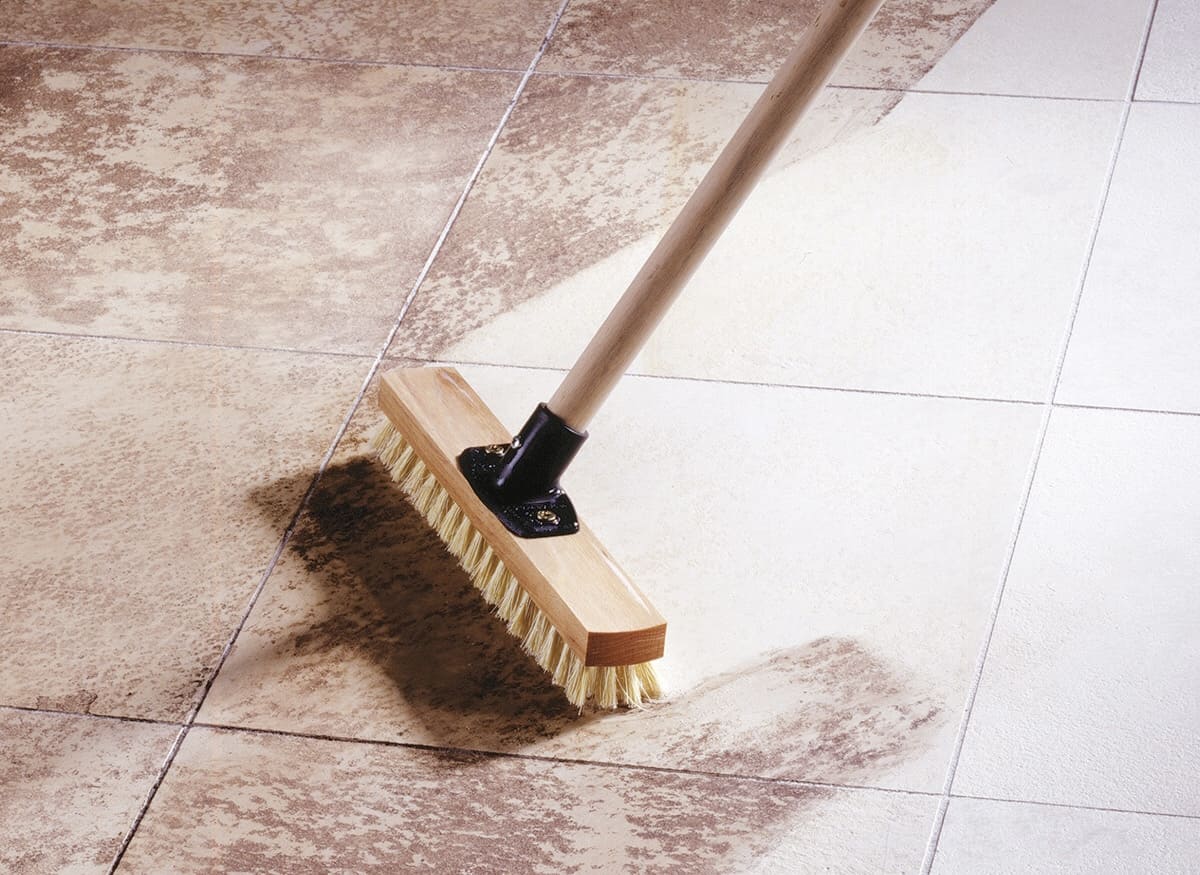
what type of cleaner should be used for natural stone cleaning?
in natural stone cleaning, stone surfaces should be cleaned with neutral cleaners that are specifically used for stone. These types of cleaners are concentrated pH neutral cleaners and they do not damage the sealing or any other sorts of stone coatings. The stone cleaners should never have acidic or alkaline ingredients. Particularly, Acids, even just a simple mix of water with a few drops of vinegar will etch and damage many types of natural stones. The best solution in many cases for natural stone cleaning is the use of a mix of a type of pH-neutral stone cleaner with warm water according to the instructions specified by the stone cleaner manufacturer. However, some types of textured stones require a different cleaning method; therefore, it’s recommended to always figure out the specific type of natural stone at hand before proceeding to the cleaning process.
Sealing
Besides techniques mentioned for natural stone cleaning, one of the common methods applied to the stones to protect them against staining is sealing. The sealing products used for stones do not seal the stones, rather, they are impregnators and work as a repellent which means they make the stone more stain-resistant and not stain-proof. Although sealing stones with impregnator sealers is a common method, many types of stones do not need any sealing. therefore, if you want to make use of stone sealing to protect them against stains, always consult with the supplier and sealing manufacturers about the type of sealing and the suggested frequency of use. Also, be sure that the sealer, particularly in the food preparation area, is non-toxic and safe for frequent use.
What if nothing worked: Restoration
If your natural stone is damaged, dull, or worn and the natural stone cleaning methods suggested in this article did not help to get the glossy look of your natural stone back, you still have the option to contact stone restoration companies out there. These companies can come to your stone’s rescue and use professional methods and equipment to restore the smooth and polished look of your natural stone.
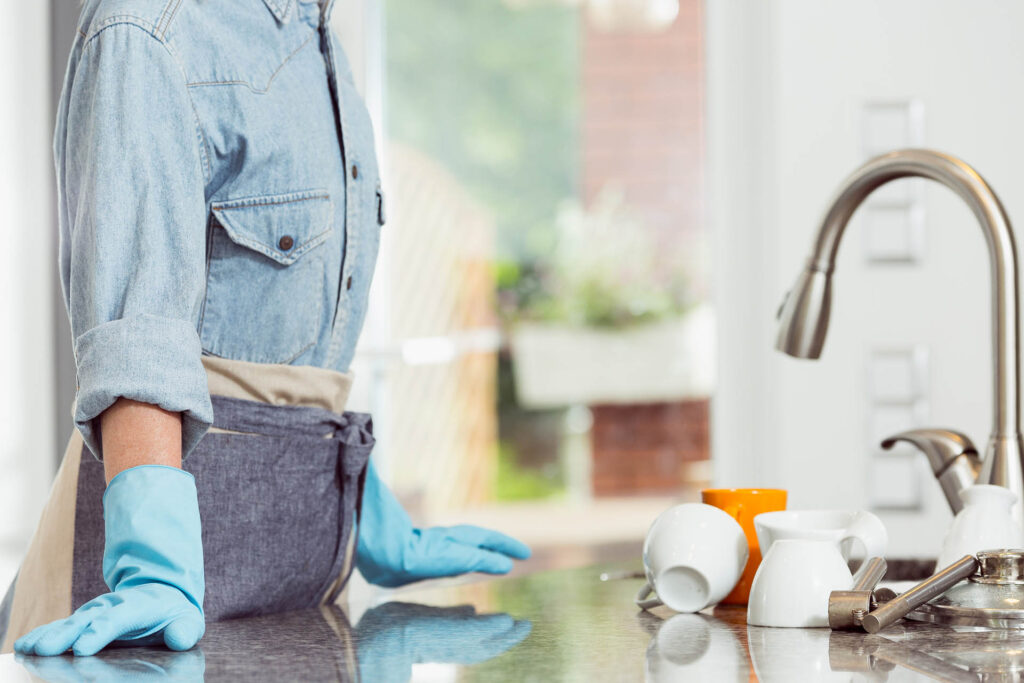
End note
Although natural stones require frequent cleaning and maintenance, their warm and natural feeling is worth going into a simple natural stone cleaning process now and then. But remember that even if you regularly take care of your natural stones, not only stones but the appearance of all-natural material changes through time, just like humans. This is the simple law of nature and can be another reason to appreciate natural stones and enjoy their authenticity, individuality, and unique change process.
references: Natural Stone Institute, Daltile, Lsi Stone, Artademous
